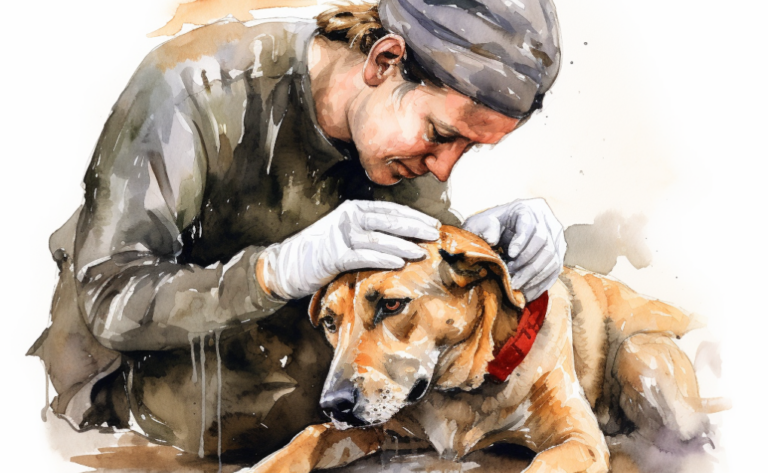Neurological Disorders in Dogs: Causes, Symptoms, Treatment
What is it?
How is it Treated?
Breed Predispositions
Cocker Spaniels Springer Spaniels Miniature Poodles Dachshunds Boxers Beagles Miniature Schnauzers Great Danes Maltese Cavalier King Charles Spaniels
One day, a pet owner named Sarah noticed that her beloved Golden Retriever, Max, was having difficulty walking and seemed disoriented. After taking Max to the veterinarian, it was discovered that he had a neurological disorder, a condition that can affect the nervous system and can result in a range of symptoms such as seizures, weakness, or changes in behavior. In this blog post, we will explore the different types of neurological diseases in dogs, their causes, symptoms, and treatment options, as well as ways to prevent them from occurring in the first place.
Neurological disorders impact the proper functioning of a dog’s nervous system, including the brain, spinal cord, and peripheral nerves. These disorders can disrupt the standard transmission of signals within the nervous system, leading to various issues affecting a dog’s movement, coordination, behavior, and overall health. The condition may involve the vestibular system, which maintains balance and spatial orientation.
There are many causes for neurological disorders in dogs, and they can affect all breeds of dogs, from young puppies to old dogs. Regardless of the reason, these disorders impair the nervous system’s ability to function optimally, leading to symptoms that may indicate a dog suffers from a neurological problem.
Understanding the various types of neurological disorders and their potential causes is essential for proper diagnosis and treatment in veterinary neurology. By recognizing the signs and symptoms of neurological issues, pet owners can seek appropriate care and intervention to support their dog’s health and well-being.
How Does a Dog’s Nervous System Work?
Like other animals, a dog’s nervous system is a complicated web of nerves, neurons, and specialized structures that send and receive information. The central nervous system (CNS) and the peripheral nervous system (PNS) are the two primary components of this organ.
- Central Nervous System (CNS): The CNS consists of the brain and spinal cord. The brain is the control center of the nervous system, responsible for processing information, controlling bodily functions, and making decisions. It is divided into various regions, each with specific functions:
- Cerebrum: Responsible for higher cognitive functions such as learning, memory, and voluntary muscle movements.
- Cerebellum: Controls coordination, balance, and posture.
- Brainstem: Regulates essential involuntary functions like breathing, heart rate, and blood pressure.
The spinal cord is a long, tubular structure that runs from the brainstem to the lower back. It serves as a communication pathway between the brain and the rest of the body, transmitting sensory information from the body to the brain and motor commands from the brain to the muscles.
- Peripheral Nervous System (PNS): The PNS consists of nerves extending from the spinal cord to various body parts. It is further divided into:
- Somatic Nervous System: Controls voluntary movements by relaying signals between the spinal cord and skeletal muscles.
- Autonomic Nervous System: Regulates involuntary processes like digestion, heart rate, and respiration. It is further divided into the sympathetic nervous system (responsible for the “fight or flight” response) and the parasympathetic nervous system (responsible for “rest and digest” functions).
The nervous system uses specialized cells called neurons, which transmit electrical signals (nerve impulses) between different body parts. These impulses are generated and sent through a complex process of electrochemical reactions involving ions, neurotransmitters, and specific channels in the cell membrane. The coordinated functioning of the CNS and PNS allows dogs to perceive their environment, respond to stimuli, and carry out various activities necessary for their survival and well-being.
Common Neurological Disorders in Dogs
Several types of neurological disorders can affect dogs. Some of the most common ones include:
Epilepsy
This is a chronic neurological disorder characterized by recurrent seizures. Epilepsy can be idiopathic (unknown cause) or result from underlying issues like brain tumors, head trauma, or infections.
Canine Degenerative Myelopathy (CDM)
DM is a progressive neurological condition that affects the spinal cord, leading to loss of coordination (ataxia), weakness, and eventually paralysis in the hind limbs. It is most commonly observed in older dogs, mainly German Shepherds.

Intervertebral Disc Disease (IVDD)
IVDD occurs when the cushioning discs between the vertebrae in the spine rupture or herniate, putting pressure on the spinal cord and causing pain, weakness, or paralysis. Breeds with long backs and short legs, such as Dachshunds and Corgis, are more susceptible to this condition.
Vestibular Disease
This disorder impacts the balance system in the inner ear, leading to symptoms like dizziness, head tilt, loss of balance (ataxia), and rapid eye movements (nystagmus). It can be idiopathic, age-related, or caused by infections, trauma, or tumors.
Encephalitis
Encephalitis is an inflammation of the brain, often resulting from infections (bacterial, viral, fungal, or parasitic), immune-mediated conditions, or toxins. Symptoms can include seizures, fever, weakness, behavioral changes, and loss of coordination (ataxia).
Meningitis
Meningitis is the inflammation of the protective membranes (meninges) that cover the brain and spinal cord. Infections, immune-mediated conditions, or cancer can cause it. Symptoms are similar to those of encephalitis.
Cerebellar Hypoplasia
Cerebellar Hypoplasia is a developmental disorder where the cerebellum, the part of the brain responsible for coordination and balance, is underdeveloped. As a result, affected dogs exhibit poor coordination (ataxia) and balance, typically from a young age.
Wobbler Syndrome
Also known as Cervical Spondylomyelopathy, this condition affects the cervical spine, causing compression of the spinal cord and nerve roots. It leads to neck pain, weakness, and an unsteady gait (ataxia) and is more common in large breed dogs like Great Danes and Doberman Pinschers.
Canine Cognitive Dysfunction (CCD)
CCD, sometimes compared to Alzheimer’s disease in humans, is a progressive decline in cognitive function due to age-related changes in the brain. Symptoms can include disorientation, memory loss, sleep pattern changes, and alterations in social interactions.
Peripheral Neuropathies
These disorders involve damage to the peripheral nerves outside the brain and spinal cord. Symptoms can include muscle weakness, loss of sensation, and difficulty with movement (ataxia). Causes can be genetic, metabolic, immune-mediated, or due to toxins.
If you suspect your dog is experiencing neurological symptoms, it is crucial to consult with a veterinarian for proper diagnosis and treatment.
What are the Causes of Canine Neurological Disorders?
A variety of factors can cause neurological disease in dogs. Some of the leading causes include:
- Genetic predisposition: Certain breeds may be more prone to specific neurological disorders due to their genetic makeup. For example, Degenerative Myelopathy is more common in German Shepherds, while Intervertebral Disc Disease is more prevalent in Dachshunds and Corgis.
- Infections: Bacterial, viral, fungal, or parasitic infections can lead to neurological disorders like encephalitis, meningitis, or vestibular disease.
- Trauma: Injuries to the head or spine can cause neurological issues such as brain swelling, spinal cord compression, or nerve damage.
- Toxins: Exposure to harmful substances like lead, pesticides, or certain medications can lead to neurological problems in dogs.
- Autoimmune disorders: In some cases, the dog’s immune system mistakenly attacks the nervous system, causing inflammation and damage, as seen in conditions like immune-mediated encephalitis or meningitis.
- Metabolic disorders: Imbalances in the body’s metabolic processes can lead to neurological issues. For example, hypoglycemia (low blood sugar) or hepatic encephalopathy (a condition related to liver dysfunction) can cause neurological symptoms.
- Nutritional deficiencies: Insufficient intake of essential nutrients, such as thiamine (vitamin B1), can lead to neurological problems in dogs.
- Congenital or developmental disorders: Some neurological disorders, such as cerebellar hypoplasia or hydrocephalus, may present from birth or develop during growth.
- Degeneration: Age-related degeneration of the nervous system can lead to conditions like Canine Cognitive Dysfunction, similar to Alzheimer’s disease in humans.
- Cancer: Tumors in the brain or spinal cord can cause neurological symptoms by compressing or damaging the surrounding nervous tissue.
- Vascular disorders: Stroke or other vascular events, which involve a disruption of blood flow to the brain, can lead to neurological symptoms.
These causes are not mutually exclusive, and sometimes a combination of factors can contribute to developing neurological disorders in dogs. Therefore, you must consult a veterinarian if you notice any signs of neurological problems in your dog, as early diagnosis and treatment can significantly improve the outcome.
Symptoms of Neurological Disorders in Dogs
The symptoms of neurological disorders in dogs can vary depending on the specific condition and the affected part of the nervous system. Nevertheless, some general signs that may indicate a neurological issue include the following:

- Seizures: Involuntary muscle movements, loss of consciousness, or uncontrolled twitching can suggest a neurological problem like epilepsy. Approximately 75 percent of dogs with idiopathic epilepsy can safely control seizures with medication.
- Lack of coordination: Stumbling, wobbling, or an unsteady gait can signal issues in the cerebellum or other parts of the nervous system, resulting in balance problems.
- Weakness or paralysis: Difficulty moving or inability to move one or more limbs, especially in the hind limbs, can indicate neurological problems like Intervertebral Disc Disease (IVDD) or Degenerative Myelopathy (DM).
- Head tilt: A persistent head tilt may indicate a neurological issue, such as vestibular disease or a brain tumor.
- Circling or pacing: Dogs with neurological disorders may walk in circles, pace, or display other repetitive behaviors.
- Tremors or shaking: Involuntary muscle movements or shaking can suggest a neurological problem, potentially leading to muscle atrophy.
- Changes in behavior or personality: Sudden aggression, increased anxiety, or other behavioral changes may indicate a neurological issue.
- Disorientation or confusion: Dogs with neurological disorders may appear confused, struggle to recognize familiar people or objects, or get lost in familiar surroundings.
- Vision or hearing loss: Sudden or progressive vision or hearing loss can suggest a neurological issue.
- Abnormal eye movements (nystagmus): Rapid, uncontrolled eye movements can indicate a neurological disorder.
- Neck pain or stiffness: Pain or reluctance to move the neck may suggest a neurological problem, such as Wobbler Syndrome or meningitis.
- Incontinence: Bladder or bowel control loss can occur in dogs with neurological disorders.
If your dog exhibits any of these symptoms or you suspect it has neurological conditions, it is crucial to consult a veterinary specialist for proper diagnosis and treatment. Early intervention can significantly improve the prognosis and quality of life for dogs with neurological disorders.
How do Healthcare Professionals Typically Diagnose Neurological Disorders in Canines?
Diagnosing neurological disorders in dogs involves a combination of clinical examination, medical history, and various diagnostic tests. The diagnostic process for many neurological disorders typically includes the following steps:
- Medical history: The veterinarian will ask questions about the dog’s health history, the onset and progression of symptoms, and any potential exposure to toxins or infections, as well as whether the dog is experiencing pain.
- Physical examination: The vet will conduct a thorough physical examination to assess the dog’s overall health, identify abnormalities, and evaluate the function of the nervous system. This examination may include checking reflexes, muscle strength, coordination, and balance, especially if the dog is usually active.
- Neurological examination: The veterinarian will perform a detailed neurological exam to pinpoint the affected nervous system area, identifying any neurologic abnormalities. This can help narrow down the possible causes of the disorder and guide further diagnostic testing.
- Blood tests: Blood samples may be taken to check for infections, metabolic disorders, organ function, or other underlying conditions that could cause neurological symptoms.
- Urinalysis: A urine sample may be analyzed to rule out kidney problems, infections, or other issues.
- Imaging studies: X-rays, computed tomography (CT) scans, or magnetic resonance imaging (MRI) may be used to visualize the dog’s brain and spinal cord, detect tumors, identify spinal cord compression, or reveal other abnormalities a condition can cause.
- Cerebrospinal fluid (CSF) analysis: A sample of cerebrospinal fluid may be collected through a spinal tap and analyzed for signs of inflammation, infection, or other abnormalities.
- Electromyography (EMG) and nerve conduction studies: These tests measure the electrical activity of the muscles and nerves and can help diagnose peripheral nerve disorders.
- Genetic testing: In some cases, genetic testing may be used to identify inherited neurological disorders or determine if a dog is a carrier of a specific genetic mutation.
- Biopsy: In certain situations, the biopsy of nervous tissue, such as a brain or spinal cord lesion, may be necessary to determine the cause of the neurological disorder.
The diagnostic process can vary depending on the specific neurological disorder suspected and the dog’s symptoms. Once a diagnosis is made, the veterinarian will recommend an appropriate treatment plan to manage the condition and improve the dog’s quality of life.
What are the Treatment Options for Neurological Disorders in Dogs?
Treatment for neurological disorders in dogs depends on the specific condition, its severity, and the underlying cause. Here are some general approaches that veterinarians may use to treat different neurological conditions in dogs:
Medication
Various medications may be prescribed to manage symptoms or address the disorder’s underlying cause. These can include anti-inflammatory drugs, pain relievers, anticonvulsants (for seizures), antibiotics or antifungal medications (for infections), or immunosuppressive drugs (for autoimmune conditions).
Surgery
In some cases, surgical intervention may be necessary to treat the underlying cause of the neurological disorder. For example, surgery might remove a brain tumor, decompress the spinal cord in cases of Intervertebral Disc Disease (IVDD), or stabilize the cervical spine in Wobbler Syndrome.
Physical Therapy and Rehabilitation
Physical therapy can help improve strength, coordination, and mobility in dogs suffering from neurological issues, which are conditions caused by a problem in the central system. This may include range-of-motion exercises, balance exercises, hydrotherapy, or assistive devices such as slings or carts.
Supportive Care
Supportive care can help maintain a dog’s comfort and quality of life during treatment. This may involve providing a comfortable environment, proper nutrition, assistance with mobility, or other measures to help manage symptoms.
Dietary Modifications
Dietary adjustments may sometimes be necessary to manage a neurological disorder. For example, dogs with hepatic encephalopathy may require a low-protein diet. At the same time, those with Canine Cognitive Dysfunction may benefit from a diet rich in antioxidants and other brain-supporting nutrients.
Alternative Therapies
Some pet owners may explore alternative therapies, such as acupuncture, chiropractic care, or herbal medicine, in conjunction with conventional veterinary medicine treatments. Discussing these options with your veterinarian or a veterinary neurologist is essential to ensure they are safe and appropriate for your dog’s condition.
Monitoring and Follow-Up Care
Regular veterinary check-ups and ongoing monitoring are essential for managing neurological disorders in dogs. This helps to assess the effectiveness of the treatment plan, adjust medications or therapies as needed, and monitor for any potential complications. Veterinary internal medicine specialists can play a crucial role in this process.
The treatment approach for each dog will be tailored to their specific condition, needs, and overall health. However, working closely with your veterinarian and following their recommendations is crucial for effectively managing neurological disorders and ensuring your dog’s best possible quality of life.
How Can You Help Your Canine Recover from and Manage Neurological Disorders?
Recovery and management of neurological disorders in dogs depend on the specific condition, its severity, and the treatment provided. Some diseases may resolve with appropriate treatment, while others require long-term management or supportive care. Nevertheless, here are some general guidelines for the recovery and management of many neurological disorders in dogs:
- Follow your veterinarian’s recommendations: Adhere to the prescribed treatment plan, including administering medications as directed, attending follow-up appointments, and making any necessary lifestyle or dietary changes to ensure a happy dog.
- Provide a comfortable and safe environment: Ensure your dog’s living space is free of hazards and easy to navigate, especially if they have mobility issues. Provide non-slip surfaces, ramps, or other aids to help them move around safely.
- Assist with mobility: Dogs with neurological disorders may need help walking, standing, or moving. Use slings, harnesses, or carts to provide support and help maintain their mobility.
- Physical therapy and rehabilitation: Regular physical therapy can help improve strength, coordination, and mobility in dogs recovering from common neurological disorders. Work with your veterinarian or a certified canine rehabilitation therapist to create a tailored program.
- Regular monitoring: Keep a close eye on your dog’s condition and watch for any changes in symptoms or behavior. Report any concerns to your veterinarian promptly.
- Proper nutrition: Ensure your dog receives a balanced and appropriate diet for their condition. Specific dietary adjustments or supplements may be necessary to support their recovery and overall health.
- Manage stress and anxiety: Dogs with neurological disorders may be more prone to stress and anxiety. Provide a calm and predictable environment, and consider using calming aids or pheromone products to help reduce stress.
- Be patient and supportive: Recovery from a neurological disorder can be long and challenging for dogs and their owners. So provide plenty of love, support, and encouragement to help your dog through this difficult time.
- Educate yourself: Learn as much as you can about your dog’s neurological disorder and its management, so you can make informed decisions about their care and be an effective advocate for their needs.
- Consider support groups or online forums: Connecting with other pet owners dealing with similar issues can provide valuable information, resources, and emotional support.
Remember that each dog’s recovery and management process will be unique, depending on their specific neurological disorder and needs. Collaborating with your veterinarian and following their guidance is essential for helping your dog maintain the best possible quality of life.
Frequently Asked Questions
Disclaimer: The information provided on this veterinary website is intended for general educational purposes only and should not be considered as a substitute for professional veterinary advice, diagnosis, or treatment. Always consult a licensed veterinarian for any concerns or questions regarding the health and well-being of your pet. This website does not claim to cover every possible situation or provide exhaustive knowledge on the subjects presented. The owners and contributors of this website are not responsible for any harm or loss that may result from the use or misuse of the information provided herein.







